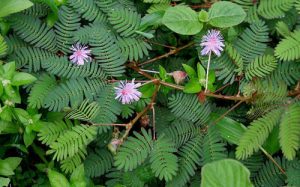 Mimosa pudica L. (Fabaceae) is colloquially known by many names, including the shameplant, sensitive plant, touch-me-not, humble plant, and live-and-die. All of these names reflect the plant’s most curious characteristic: rapid movement in response to environmental stimuli, notably by touch, but also by shaking and electrical stimulation. Nastic movements in plants are those that are caused by environmental stimuli, M. pudica exhibits thigmonasty (rapid movement to touch stimulus) in addition to nycintasty (leaf movement in response to light/dark changes). The movement in response to touch stimulus is thought to be a means of defense from herbivores, which could be scared by the rapid movement. Additionally, the closed leaves of the plant look like a less satisfying meal, and the closed leaves expose the thorns that the plant possesses. Nyctinastic movements are thought to be a measure for water preservation, and is a trait found in other members of the Fabaceae.
Mimosa pudica L. (Fabaceae) is colloquially known by many names, including the shameplant, sensitive plant, touch-me-not, humble plant, and live-and-die. All of these names reflect the plant’s most curious characteristic: rapid movement in response to environmental stimuli, notably by touch, but also by shaking and electrical stimulation. Nastic movements in plants are those that are caused by environmental stimuli, M. pudica exhibits thigmonasty (rapid movement to touch stimulus) in addition to nycintasty (leaf movement in response to light/dark changes). The movement in response to touch stimulus is thought to be a means of defense from herbivores, which could be scared by the rapid movement. Additionally, the closed leaves of the plant look like a less satisfying meal, and the closed leaves expose the thorns that the plant possesses. Nyctinastic movements are thought to be a measure for water preservation, and is a trait found in other members of the Fabaceae.
The shameplant is native to Central and South America, and has been introduced to Australia, South and Southeast Asia, and many Pacific Islands, where its regarded as an invasive species. Intentionally, it is cultivated as an indoor houseplant, mainly for its curiosity value. As a weed, M. pudica affects crops, and can also be found as a forage plant in pastures (where its presence  is tolerated/valued, unlike in the middle of a crop field). The plant is shade-intolerant, and grows mostly in nutrient-poor conditions. Like many of its family members, the plant forms a symbiotic relationship with nitrogen fixing bacteria, which lives in its root nodules. These bacteria convert atmospheric nitrogen into a form usable for the plant.
is tolerated/valued, unlike in the middle of a crop field). The plant is shade-intolerant, and grows mostly in nutrient-poor conditions. Like many of its family members, the plant forms a symbiotic relationship with nitrogen fixing bacteria, which lives in its root nodules. These bacteria convert atmospheric nitrogen into a form usable for the plant.
The sensitive plant is used in many capacities in traditional medicine. In India, pulped leaves are used for glandular swelling, and leaf sap is a treatment for sinus disorders and sores. In the Republic of the Congo, the entire plant is pulped and applied as a treatment for pain in the body side and kidneys. In Senegal, the leaves are used as a treatment for lumbago and nephritis. In Southeast Asia, the plant is used for sleep disorders.
More generally, traditional medicine also uses M. pudica to treat dysentery, urinary complaints, snake bites, glandular tumors, and uterine cancer. The root extract has antibacterial activity, and is additionally thought of as an aphrodisiac. The seeds have purgative and emetic properties. The green parts of the plant are used as analgesics, antispasmodics, anti-asthmatics, mild sedatives, and antidepressants. High doses can be toxic, and the plant is not yet used in Western medicine as pharmaceutical companies are still researching its properties. Scientific studies have shown that the plant has properties of a diuretic, it can depress duodenal contractions, promote regeneration of nerves, and reduce menorrhagia. In terms of environmental healing, the plant has been shown to have the potential for phytoremediation of arsenic polluted areas.
of the plant are used as analgesics, antispasmodics, anti-asthmatics, mild sedatives, and antidepressants. High doses can be toxic, and the plant is not yet used in Western medicine as pharmaceutical companies are still researching its properties. Scientific studies have shown that the plant has properties of a diuretic, it can depress duodenal contractions, promote regeneration of nerves, and reduce menorrhagia. In terms of environmental healing, the plant has been shown to have the potential for phytoremediation of arsenic polluted areas.
The plant has been used in memory research, to test if plants can habituate to a stimulus and remember that behavior over time. Experiments have showed that plants dropped from a non-harmful distance learn to habituate to the stimulus, and stop closing their leaves in response to the dropping stimulus. However, this is not due to exhaustion- once a novel stimulus, like shaking, is applied, the plant will close its leaves once more. Once the plants habituated to the dropping stimulus, they were left alone. 28 days later, the plants still “remembered” that the drop was a non-harmful stimulus, and upon being dropped did not close their leaves. Another study was done similarly, but tested plants grown in high vs low light conditions. Since the closing of the plant’s leaves impedes photosynthesis, researchers hypothesized that those plants grown in low light conditions would habituate to dropping faster than their grown in high light counterparts. This hypothesis proved true, and even upon moving the plants to different light conditions, the plants still “remembered” that the drop was not a stimulus worthy of reaction.
This curious plant grown for its interesting behaviors, is also and invasive species, weed in crop fields, forage plant, medicinal plant, plant consciousness research tool, and more. The sensitive plant M. pudica occupies a large varieties of functions and ecological niches, and has enchanted many people with its bashful behavior.
